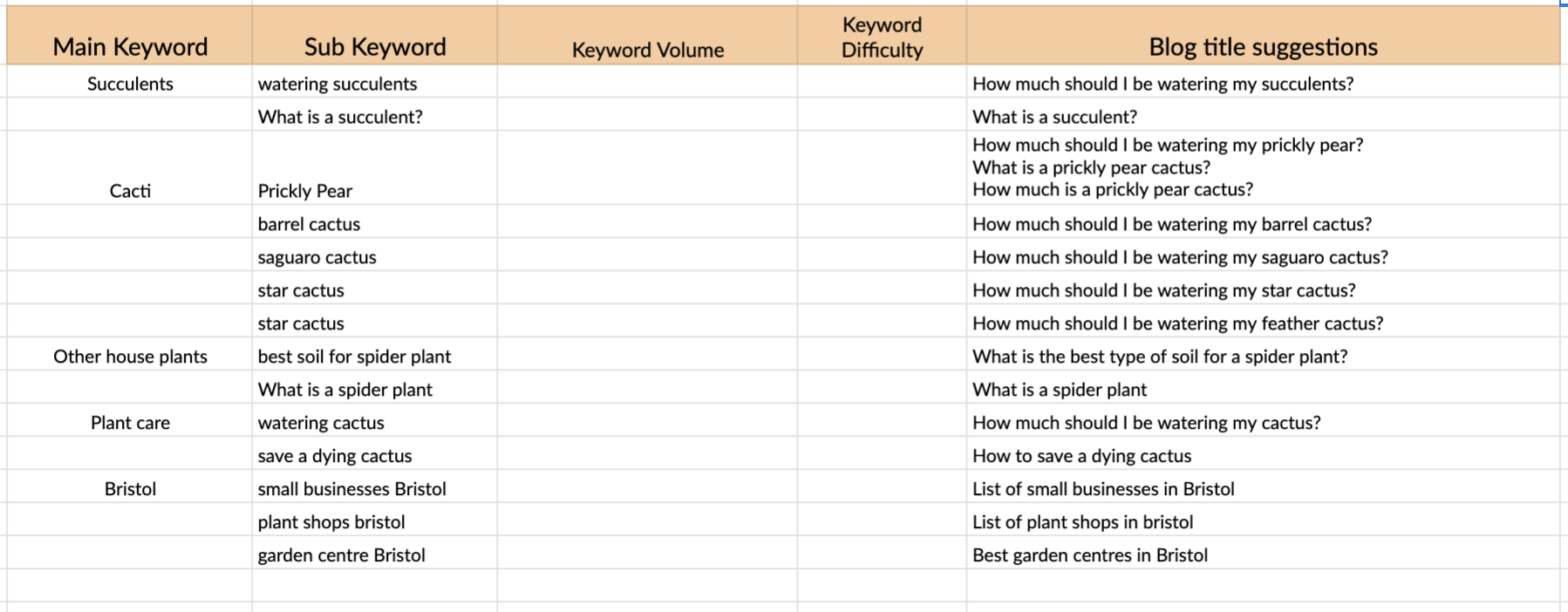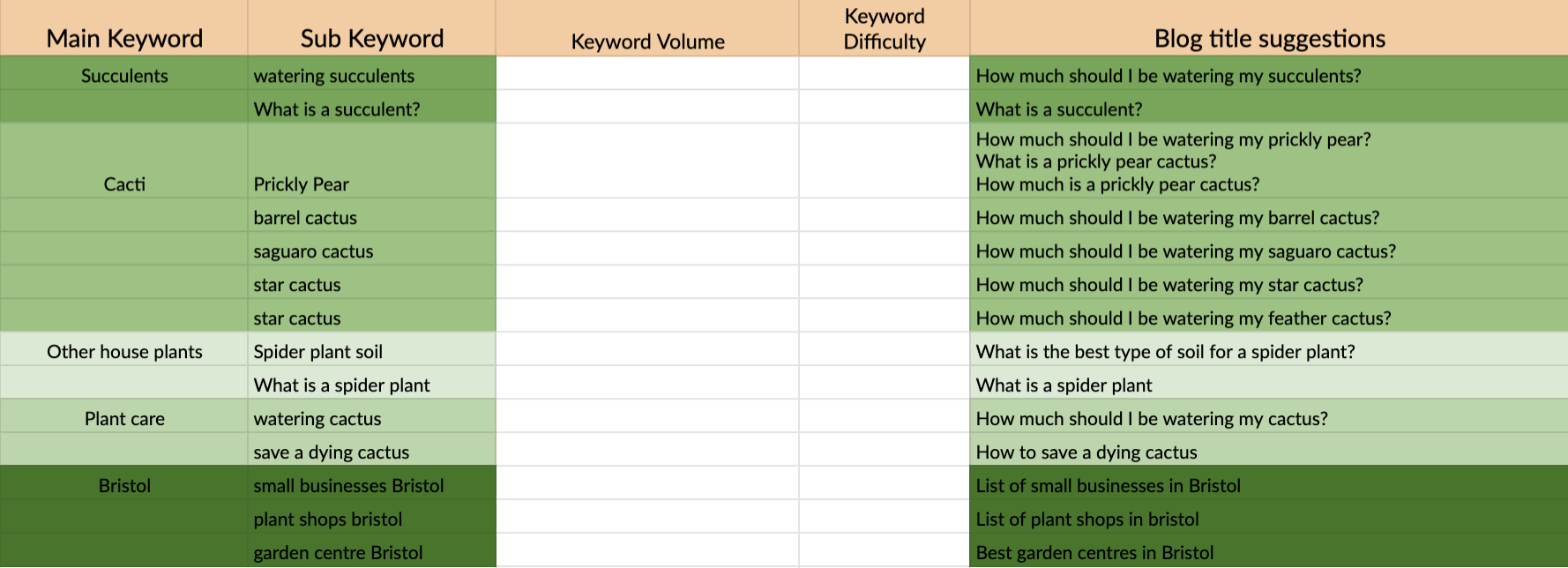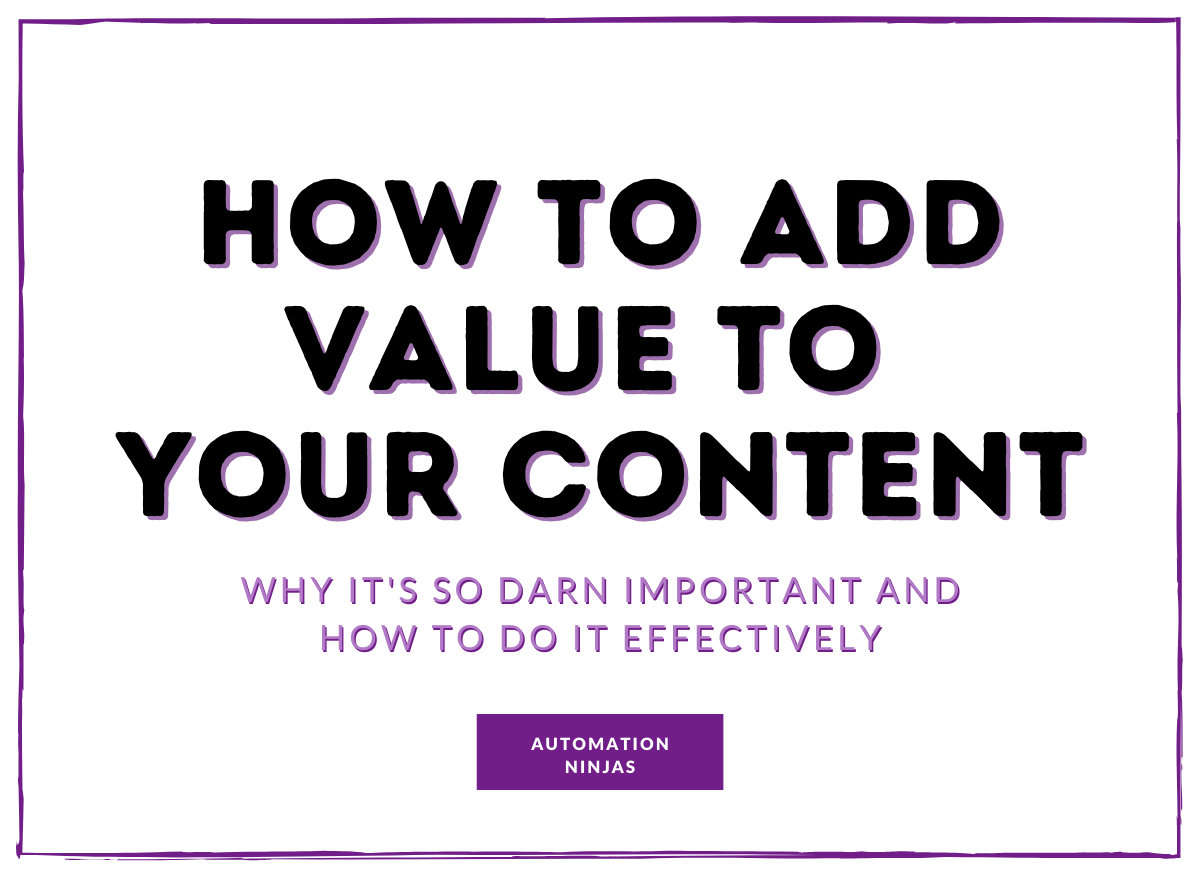I’m laying out how to create a powerful blog content plan.
A lot of people don’t know where to start with a blog content pan. A lot of our clients don’t have one, and their reasoning is that ‘they don’t need one’ - yet they’re voicing disappointment at not showing up in search results, not seeing consistent blog hits, and not getting the leads in that their business requires.
Settle in with me and commit to creating your blog content plan. Plan the work and work the plan.
There are 4 main steps to creating a blog content plan
1. Finding the keywords and keyphrases which your blog shows up in search results for
2. Thinking of all the specific keywords and keyphrases you want to show up for in search results, which you currently aren’t
3. Diving into keyword metrics - you need to research which of both of the above have good search volume - ie. lots of people searching for them
4. Putting all that info together, so you can create a plan of action of the blog titles you could create content for
I’m going to go through each of those, step by step for you. The aim here is creating a blog content plan which gives you a solid 3 months worth of blog content titles, all selected based on good metrics.
I’d recommend that you repeat your keyword research every 3 months as the metrics for keywords can change over time, and what was once a ‘hot topic’ can become less hot, or can become very difficult to rank for - in which case, other keywords/keyword phrases may trump what you thought you’d need to write about next.
So, let’s start at the beginning.
Step 1: Find the keywords and keyphrases which your blog shows up in search results for
Here is where we have some tools to recommend.
It’s likely that you’re using Google Analytics, but are you making use of Google Search Console? It’s a great (free!) tool which tells you how you’re ranking for each keyword.
It can be a powerful place to start in creating a content plan - GSC will tell you what your site visitors searched for to find your website. If you have this set up for your site, go in and extract your search terms) and if not - set Google Search Console up - stat! Here’s Google’s guide.
Step 2: Think of all the specific keywords and keyphrases you want to show up for in search results, which you currently aren’t
Here is where the meat of the work is. What I’ll guide you through is basically a big brainstorm. When doing this for our clients, we create one big list. (Then we add all the ideas into a big spreadsheet - more on that in a minute)
Your big list is where you directly write out the ideas you have about what people might search for which relate to your business offering. You need to step into the shoes of your prospects and customers (and dream prospects and customers) here, and imagine the things they’re looking for information on.
Here are some prompts to help you generate your list of ideas for your keywords/key phrases:
To make this super tangible for you, I’m pretending that I’ve got a house plant shop business here in Bristol, so in the list below, you’ll see some of the answers I came up with, with my blooming house plant business in mind!
How would you summarise the main things your customers are worried about? Drill down into the specifics where appropriate.
- How do I keep my cactus alive?
- How much should I be watering my cactus?
This question can be drilled down into, like this:
- How much should I be watering my prickly pear?
- How much should I be watering my barrel cactus?
- How much should I be watering my saguaro cactus?
- How much should I be watering my star cactus?
- How much should I be watering my feather cactus? - How much should I be watering my succulents?
- How much should I be watering my air plants?
- What’s the ideal temperature for a x plant
- Should I keep my x plant near a window?
- How do I keep my x plant healthy?
- What’s wrong with my x plant?
- Why does my x plant look so unhealthy?
- When should I propagate my x plant
What are the ‘What’s the best’ type of questions you have received / can imagine people asking?
- What’s the best plant for indoors?
- What’s the best way to repot an x plant
- What’s the best cactus for kitchens?
- What’s the best shop in Bristol for house plants
- What are the best house plants for a new home
What would really help people achieve mastery in the type of thing you offer?
- What does a healthy cactus look like?
- How can I make sure my plants never get sick?
- How do I take cuttings of my house plants
Think of specific questions for all of the services/products you offer
- Where can I buy house plants in Bristol?
- Buying plants online
- Plants getting damaged in the post
- Returning plants bought online
What questions about cost might people have?
- How much is a 5 ft cactus?
- How much are plant cuttings worth
- How much should I spend on a x plant
What things might people want to compare?
- Cacti vs Succulents
- X plant vs x plant - which is better for a kitchen windowsill
What ‘How to’ questions might people have?
- How to become a better gardener
- How to take better care of house plants
- How to save a dying cactus
- How to spend less money on house plants
What ‘What is’ questions might people have?
- What is a succulent?
- What is a spider plant?
- What is the best type of soil for x plant?
- What is propagation?
What type of ‘reviews’ questions might people have?
- Reviewing x soil type for my x plant
- A review of different plant pots
- A review of plant care techniques
- A review of the air quality 2 types of plants create
What other ancillary questions might people have, which you’d like to show up in search results for?
These are things which relate to your business… but not necessarily things you offer in your business. This part of the list is likely to be MASSIVE. Get that thinking cap on!
- Kitchen jungles
- Plants for patios
- Best garden centres in Bristol
- Supporting small business
- List of small businesses in Bristol
- List of plant shops in bristol
- Plant shops in the South West
- Are house plants good presents?
- What makes a good house warming present?
- What makes a great birthday present?
- Which plants are lucky?
If you’re struggling to answer some of those prompts, sit down with your colleagues first and foremost, they have high knowledge of the business, and may have slightly different insights to you.
After you’ve asked your colleagues, then reach out to friends and family - the things they think of are likely to be golden because they’re not so close to the business. You might find that there is a bit more room for them to be more creative in their thinking.
Oh! Know that there might be cross over with some of the list you have - that’s ok. This is why we do the next bit, cataloguing your ideas and putting them into some categories.
A good content plan helps people strategically devise what content they need to create. The instructions later on in this blog will show you how to handle the metric side of things, but right now I want you to consider this...
How to optimise your blog posts for SEO
What blog content will provide value to your audience?
Google looks for keywords within a sentence. Ie. if someone asks ‘Best marketing automation providers in UK’ the keyword is ‘marketing automation’. But it’s hard to rank for that. What we need to do is get ranking for long tail search terms. And the more long tail content you create, the more likely you are to rank for those shorter keywords too.
Once you’ve got together a list of keywords which you imagine (or have proof of!) people googling to find your site, you can start to organise your list a little. You might have even thought of some content titles already - and that’s a good thing. There are certainly lots of them in the list I created above for my plant shop business.
So now, it’s time to create a spreadsheet.

Spreadsheets! Yes!
We’re going to use one sheet to list out your main keywords and your sub keywords. It’s in this sheet that we’ll then do the keyword research.
Use the following headings:

In the ‘Main Keyword’ column, I want you to segment out what the main keywords could be categorised as. You should have a main keyword for each of the main services/products your business offers: ie. for my plant business, I’d have succulents, cacti, other house plants and plant care. Those 4 relate directly to the services I offer.

Then think if there could be any other categories which would be useful for grouping some of your sub keywords - there’s no hard and fast rule to this, it’s just helping you be more organised, so from my list above, I can see that a useful main category for my shop could be ‘Bristol’ as I came up with quite a few keyword phrases which include Bristol.
I would then work through my big long list of ideas, and paste in some sub keywords into my ‘sub keyword’ column. Two things here:
- Yes there may be some crossover between the categories, and that’s ok. My question of ‘How much should I be watering my succulents?’ could fit into either the ‘Succulents’ of the ‘Plant Care’ main category, and I’m going to choose the ‘Plant Care’ category for that one.
- That question of ‘How much should I be watering my succulents?’ is a blog title in itself, don’t you think? I’m going to reduce it down to a short keyword phrase, which would be ‘Watering Succulents’ and then I’m going to pop my idea of ‘How much should I be watering my succulents?’ in the Blog title suggestion’ column for that row.
So now you can see the blog content plan coming together:

I’ll create a new row if I have a new sub keyword to enter for its main keyword.
Colour coding is your friend here, it’ll help segment visually into the categories:

This process will likely take you a good couple of hours, so settle in and get the hard work done! And if you’re hating this task, give yourself some talking to - persevere! It’s getting stuck into the ‘big work’ like this which pays off big time in the long run.

Get it done!
Step 3: Time to dive into keyword metrics for your blog content plan
When Google is looking for an answer to a question a user asks, it looks for:
- Domain Authority
- The best answer to the question
- Things are related to that topic which are getting engagement
By now you’ve got a wacking great list of your fab keywords - let’s see what their metrics are…
How do you work out what the best keywords are to rank for?
We love using Mangools for our keyword research. Its Keyword Finder Tool is excellent. They brand themselves as having ‘Juicy SEO Tools’ and we completely agree with that juiciness.
Mangools has a few tools in its briefcase:
KW Finder: Keyword Lookups / Keyword Tracker: Helps you find the keywords you want to rank for. It’s got tools which helps you to keep an eye on change of your keyword ranking over time
SERP Checker: SERP Lookups / SERP Watcher: Shows you where you’re ranking for certain keywords / helps you check up on websites
Link Miner: Shows you what backlinks your site has
Site Profiler: Site Lookups: This can come in very useful for competitor audits!
I’m going to show you Keyword Finder - the tool which allows us to look up your keywords. (We recommend getting a paid account which will give you 100 Keyword searches a day.

Type in your keyword. Ooo, I get to go back to my plant shop! I’m going to pop in ‘watering succulents’ and see what Mangools churns out. I’m setting the location to the UK as that’s where my true competition is.
Here’s what I got:

And here’s what those columns mean:
Search: How many people are searching for this keyword (in the location you set), per month - on average, for the past year
CPC: Average cost per click - how much £ would it cost to create 1 click through to site
PPC: Level of competition on paid ads on Google
KD: Keyword Difficulty - as calculated by Mangools. This number is out of 100, how hard is it to rank for that keyword?
The lower the number, the easier.
The most important metric here is the Keyword Difficulty.
So from my example search above, I can see that ‘watering succulents’ has a pretty good monthly search volume (640 searches) , and the keyword difficulty is pretty good (34).
So that’s a YES from me! The keyword is good enough to stay on my content plan. I’m going to add those metrics in:

If any metrics are not as great - either having a very low search volume (for us, the criteria is more than 100 searches a month), or high difficulty (for us, we try not to create content for anything with KD of 50+) then don’t be afraid to remove it from your list.
(One note I want you to bear in mind here is that some keywords might not get lots of search content, but that content will be amazingly useful for your audience still. Maybe it’s something which could trend in the future, or it’s proper expert-level stuff. Because of this, creating content which hits those low-search keywords can still be important, it could be seen as great 'read more' content in your blogs, and/or content to send people to in your advertising.)
There are three ways Mangools gives your more keyword ideas from that first keyword you put in:

1. Suggestions: the way that keyword and its suggestions rank
2. Autocomplete: what autocomplete options are there?
3. Questions: what Q’s are people asking relating to the keyword?
It’s all quite organic this process. Each time you pop your keyword idea in - in this case, we’re still on ‘watering succulents’, I want you to make use of the ‘related keyword’ tab, which will show you some suggestions of those other keywords.
Go through the list, picking out topics, based on these guidelines:
- What keywords could you create content around?
- Which have a low Keyword Difficulty?
- And a good amount of people searching for that keyword.
So you can see from the keyword search findings above, Mangools had ‘Cactus Plants’, ‘Succulents for Sale’ and ‘Succulent soil’ as three related keywords which have excellent metrics. I like them! I’m going to add them to my content plan, and add those metrics in.
After you’ve taken what you like from the related keywords’ tab, hit the ‘autocomplete’ tab, and do the same - pick out any good keyword phrases which appear here.
This was one which appeared for me - ‘overwatering succulents’.

Love it! I might not have thought of that as a keyword phrase. It’s got excellent metrics, I’m adding it to my content plan immediately!
I then do the same when I click on the ‘questions’ tab. Google users LOVE to type in full questions when researching a topic, and if you title your content as a question, you’re likely to be there to answer their question with an excellent piece of content.

If you follow those steps for diving into your keyword metrics, it’s going to be quite possible to rank for the keywords and they would be great topics to create your blog content plan around.
Step 4: Put all that info together, so you can create a blog content plan
So once you’ve gone through your whole list of great ideas for keywords, checked on their metrics, added in all the suggestions Mangools comes up with, you’re likely to have a pretty great big list.
Remember to make sure you’re trying to categorise it appropriately, there’s no hard and fast rule to this, just make it as useful to you as possible.
Time now to fill out the ‘Blog title suggestions’ column. (And you may also do this as you along Step 3 - good for you!) Think of the content titles which incorporate each keyword. Make your blog titles really clear and something which is enticing to read.
A few more examples for you here -
Sub Keyword: ‘overwatering succulents’ >
Ideas for Blog titles:
- ‘How do you stop overwatering succulents’
- ‘How do I know if I’m overwatering my succulents?’
- ‘Top tips to help you stop overwatering succulents’
- ‘Try this method to stop you overwatering your succulents’
- ‘Underwatering vs overwatering your succulents - which is worse?’
You just want to choose 1 blog title, but if you think of great alternatives, make note of them - you could create another blog on that topic further down the line.
Once that’s all done, it’s time to make a plan. Remember that the aim here is create a content plan which gives you a solid 3 months worth of blog content titles, all selected based on good metrics…
How often will you post content? For my plant business, I want to be putting out 2 blogs a week, which, over 3 months is a total of 13 pieces of content. I’m going to go through my mega list of blog title suggestions and pick out the ones I want to create content for in the next 3 months. Be sure to ad a check box / strike through in your content plan when you have selected that keyword phrase.
And finally, Set some goals around your blog content plan's creation
Having clear targets in mind will not only increase your motivation and provide that precious ‘kick up the jacksie’ to create your content, but it can also be a great benchmark of how well your efforts are working - and if you are getting the results you’re looking for. But please do manage your expectations here... creating blog content can take a while to create results in the traffic you’re getting to your site.
Here’s a couple of suggestions for things to track:.
- Organic search increases from x average in 2019 to consistently getting x organic search hits per month in 6 months time
- Organic search time on site increases from x (average in 2019) to x average in 2020
So there’s the Ninja process for you, I really hope you found that useful and you’re raring to go with devising you next 3 months worth of content. Now is the time to start approaching your blog content plan in a structured and measurable way. Commit to consistently creating regular, focused and relevant content for your website.

Sign up to the Brainbox to stay in the loop with the latest marketing news and exclusive content
Or, if you have something specific in mind, reach out to us directly. We're all ears and ready to chat! Contact us here.





